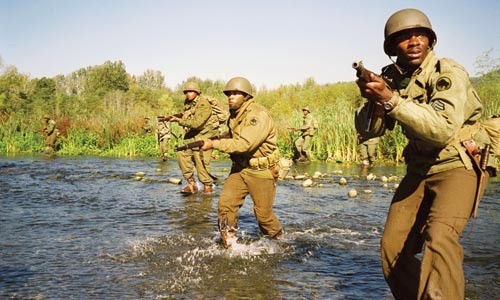In the waning days of World War II, the black American soldiers in Spike Lee's new movie find themselves pinned behind enemy lines, in an Italian village where fascist posters cruelly caricature blacks. In one scene, the soldiers pause to glare at the lurid images. Then they tear them from the wall.
Lee's own purpose -- to shred racist stereotypes about World War II -- is largely the same in Miracle at St. Anna, but only largely. Lee also wants to tell a ripping war yarn, and to cap it all with a redemptive, quasi-magical ending. The sum of his efforts overburdens a laudable project.
Miracle, adapted by James McBride from his novel, follows four members of the Buffalo Soldiers, a black division in the still-segregated military. They're trapped in the mountain villaggio thanks as much to their white commander's racism as to the firepower of the weakening Nazis. Sympathetic villagers and a traumatized 8-year-old boy set the scene for a showdown with the Germans sparked by a partisan fighter's double-dealing.
Because Lee has publicly criticized the absence of blacks in other World War II movies, we expect Miracle to redress the grievance. It does. Here, Nazi radio propaganda stings -- both us and the characters -- because these Buffalo Soldiers are fighting for a country that denies them basic rights. Lee vividly illustrates the point with a sequence in which a small-town Southern soda-fountain owner serves ice cream to German POWs but tells black GIs to go 'round back. (The soldiers take bitterly comic revenge.)
This is powerful stuff, and Lee should have let it speak for itself. Instead, every reel or so he stops the story dead for a ponderous speech or dialogue, to make sure we don't miss the point. Occasionally one of these discourses offers an intriguing idea: One soldier, for instance, says he's based his future on America's improving -- but what if it doesn't? Then the story resumes.
Lee skillfully stages a classically styled war film, including a harrowing civilian massacre and a gut-wrenching climactic firefight. And while his GIs themselves verge on stereotype -- the gold-toothed Lothario; the hulking but childlike soldier; the quiet, intense one -- some depth emerges in womanizing Bishop (Michael Ealy); big, soft-hearted Train (Omar Benson Miller); thoughtful Stamps (Derek Luke); and watchful Negron (Laz Alonso).
But the film is hobbled by the drawling racism of a cardboard U.S. officer (scarcely more nuanced than Axis caricatures of blacks) and Lee's portraits of secondary characters. He strives to humanize Italian villagers and even German soldiers; but he doesn't really know these people, so the characterizations are musical (rustic airs for the Italians) and rendered in dialogue that could have been cut-and-pasted from a hundred other war films.
Still, point made: Buffalo Soldiers, too, were hailed "GI! GI!" while tossing Hershey bars to European rugrats. And like soldiers of any color, they killed and died. Ably enough, Lee's put a Hollywood face to that history.















